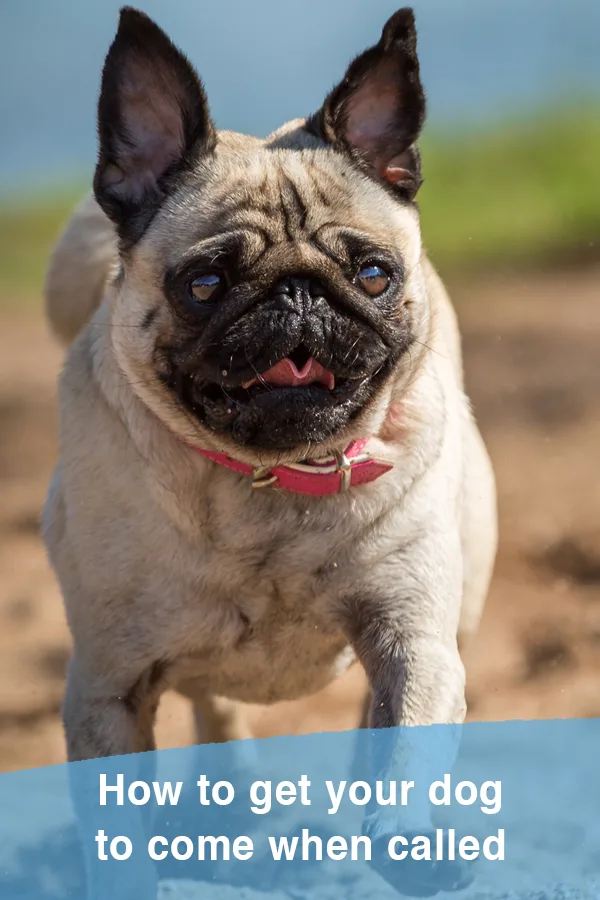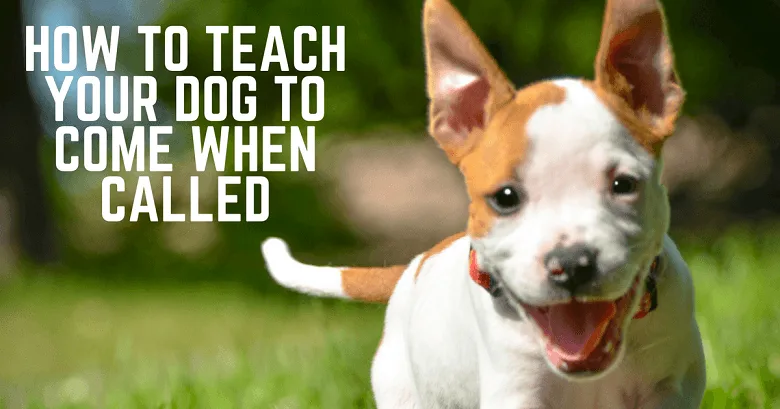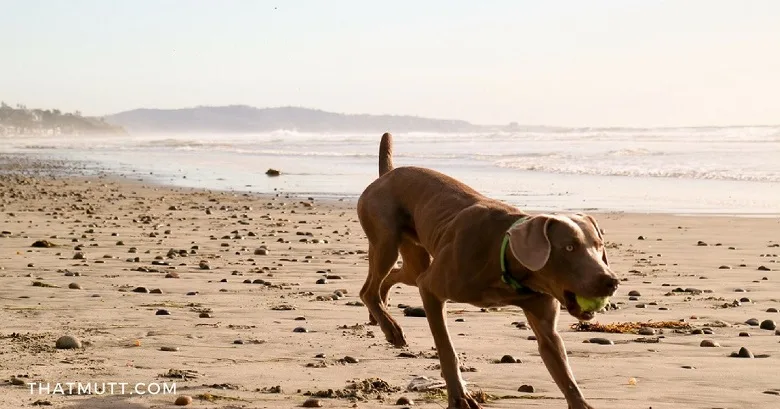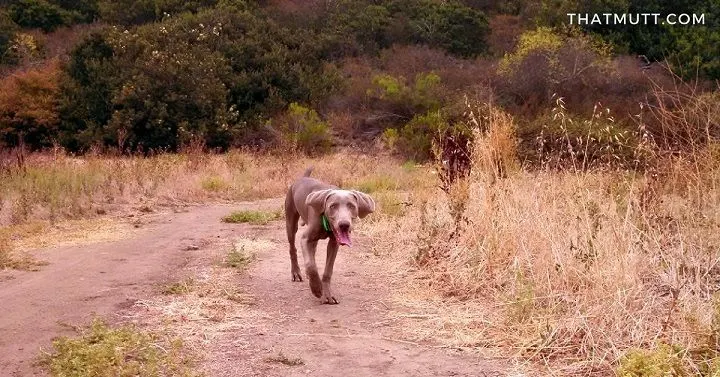Today’s focus: How to teach your dog to come when called. Also called “the recall” in the dog training world.
How are the rest of you doing with this one? Any struggles or suggestions to share with the rest of us?
How to teach your dog to come when called
I follow these rules for teaching my dog to come when called:
- My dog almost always gets a big “payout” for coming to me, whether that is more freedom or a high-valued piece of food.
- Only say the command once. And I use my dog’s name. So it’s, “Remy! Come!”
- Do not call my dog unless I am 99% sure he will obey or that I can reinforce it instantly by “reeling him in.”
- “Come!” means “Come to me and sit in front of me.” (It doesn’t mean “crash into me” or “nip at me as you run by” or “dance around me just out of reach!”)
- If possible, I don’t call my dog when we’re doing something “bad” like a nail trim or leaving the dog park. Instead, I just go and get him.
How to teach your dog to come when called

1. Set your dog (and you) up for success.
Start with the easy stuff.
I call Remy indoors in boring situations where I’m the most exciting thing so of course he’s going to come when I call him. For example, if we’re sitting in my home office and I call him, he listens. There’s nothing else going on. Good boy!
Another “easy” scenario you can set up at home is to toss a treat, let your dog go get it and then call him and give another treat.
If your dog loves walks, call him before his walk. Loves to eat? Call him before you feed him.
And if he doesn’t get too excited and start biting and jumping (like Remy does) you can make a game of calling your dog back and forth between you and a family member down the hall.
See my post: 10 ways to get your dog to come when called
2. Use a leash and treats and increase the challenge very slightly.
When you have a leash on your dog, you know you can reinforce it when you all him. So call him once and then “reel him in” if he doesn’t come on his own. Then lots of praise!
If your dog is on a leash, you can start practicing “come!” with some mild distractions like outside on a walk or perhaps in your backyard.

Tip: Use highly valued treats when working on the recall. If your dog gets a real meatball every time you call him, don’t you think he’s going to have a pretty good recall?
I normally don’t use a lot of treats with Remy because he gets too excited, but I use them for coming when called. We like to train with the Zuke’s minis treats.
Another tip: I don’t tell my dog to “stay” and then call him because it encourages him to break from stay. Remy is still young and needs to work on a solid STAY command.
If you want to leave your dog and then call him, I recommend you use a “wait” command. This is great for sports like agility too.
So “stay” means “stay until I return and release you.” “Wait” means “wait until I give the next command.”
3. Buy a long leash at least 15 feet long.
I just bought a 30-foot lead for Remy, and I highly recommend it. I plan to use this for calling Remy outside in random areas so we can work on a little distance but I’ll still be able to somewhat prevent him from running off.

Order Mendota’s 30ft check cord HERE. I like this style because it does not have a handle to catch on brush. My dog can move freely in a field.
Make sure to wear gloves so you don’t burn your hands. Even better, just step on the leash vs. grabbing it. Also, it’s best to remove prong collars for this exercise in case your dog hits the end of the leash hard.
Over the weekend Josh and I took Remy to a park and practiced calling him back and forth between us while he wore the long lead. Remy had a blast! He thought this was a fun game, we were the ultimate rewards and he got some good exercise too!
Tip: Don’t do this for too long or the dog might get bored or distracted. We probably practiced this for about 4 minutes. We stopped while we were all still having fun. Good choice.
Another tip: A retractable leash can work pretty well for this too if you have a mellow dog, a puppy or a small dog. It would be dangerous to use one for my powerful weimaraner, though. That would be like reeling in a tiger with a yo-yo. Someone would get hurt.
4. Practice! Practice! Practice!
The key is setting your dog up for success by not making the distractions too difficult at first.
The mistake many of us make is we expect too much too quickly. Instead, we should v-e-r-y s-l-o-w-l-y over several weeks, months and years increase the level of difficulty only as our dogs are successful.
So that means lots of practice in “easy” scenarios first. Every day.
For example, with Remy, I can call him indoors and he’ll pretty much always listen. Outside at the fenced dog park he’ll come when called if there are no other dog around and if I’m holding treats. If he’s on a leash outside, he’ll pretty much always come when called.
But, it’s too challenging for Remy right now to come when called off leash in most scenarios unless the distractions are very mild (no other dogs around, we’re in a fairly ordinary place, etc.) or if I’m holding a high-value reward such as hot dogs or a squeaky toy!
It’s about knowing your dog and challenging them ever so slightly but also making sure you’re both successful.
See my post: 5 mistakes people make when calling their dogs

Other tips for how to teach your dog to come when called
- Don’t call your dog for “bad” things like putting him in his kennel, trimming his nails or leaving the dog park. Instead, just go get him or wait for him to come to you. Reward him with food when he checks in with you on his own.
- Sometimes the best reward is more freedom, not praise or a treat. Call him, then let him go back to playing or sniffing!
- Make a game of it – Hide in another room or run from your dog so you are the prize.
- Practice for 5 minutes at least a few times per week. No need to work longer than that or the dog gets bored.
- Sign up for an obedience class, either a beginning level if that’s where you’re at or a more advanced class.
What about really ‘stubborn’ dogs?
I don’t know that there are “stubborn” dogs but maybe just dogs that are very driven to follow their nose or to hunt. And then there’s dogs that just love other dogs so much! And another problem is when dogs don’t get a lot of off-leash freedom they don’t want to return because the fun ends!
For problems like not coming when called around distractions like other dogs, squirrels, a dead bird, etc., what it comes down to is a solid foundation.
Start from the beginning and if he comes 99% of the time without distractions, start adding mild distractions. Work up to slightly higher distractions, then medium, etc.
And really up the reward any time you increase the challenge. Use hot dogs, pieces of real meat, that squeaky toy that makes him nuts, whatever it might be!
Heck, sometimes, it’s worth it to let him have that freaking dead bird or to go back to chasing that rabbit or whatever it might be if he actually came to you! Sometimes it’s worth it! (Yes, I know there are risks. You pick your battles.)
What about using an e-collar to teach your dog to come when called?
When you use an e-collar, do not think of it as a punishment but more of a quick “tap, tap” like “Hey! I’m over here! Remember me?” It’s great when your dog is out of your voice range. For example, when you’re hunting.
If you decide to use an e-collar for your dog, do so AFTER he understands what “come” means. And, do not practice with the collar in areas that are too distracting for your dog. That is not fair. You need to slowly work up to more distracting environments.
I personally use the Garmin Alpha 100 with my dog Remy and have had a lot of success using the vibration mode to get my dog’s attention when he’s off leash. I taught him that the vibration means to come to me and get a treat. Then, I generally release him back to go run and sniff some more.
Check out my review of the Garmin Alpha 100 here
You also have to remember to work within your dog’s abilities. Just because he has an e-collar on, you still have to remember he can only handle certain distractions. Don’t challenge him too much. It’s not fair.
So what I would do with the e-collar is use it in combination with a long leash at first. Call your dog once. “Remy, come!” If he comes, great! Lots of praise. “Wooo!”
If not, give one “tap, tap” with the vibration mode and pull on the leash to get his attention. Then lots of praise when he moves towards you.
It’s best to have him on a long leash (25 ft) when you first practice this. The e-collar is a lot like a tug on the leash to get your dog’s attention. In fact, you should think of it as an extension of the leash. Then you can phase out the long leash.
Tip: Have your dog wear the e-collar for part of the day a week before you even turn the thing on. That way he’s used to wearing it and won’t associate a vibration or correction from the collar.
Also, try the collar on your own skin before you put it on your dog so you understand the level of intensity. I always try it on the underside of my wrist. There are lots more tips for e-collars in this post.
So those are my suggestions for teaching your dog to come when called.
What tips would you add to this list. What’s worked for your dog? Or do you have any questions?
Let us know in the comments! Always helpful to hear from others as we could all use some feedback at times. Clearly Remy and I could use some help too!
Related posts:
SOME OF MY FAVORITE TRAINING PRODUCTS:
- Wellness treats.
Wellness Well Bites are treats almost all dogs are willing to work for and focus on! - Treat bag.
Carry your treats in a convenient treat pouch around your waist so you’re always ready to reward your dog for heeling, coming when called or paying attention to you. - Gentle Leader.
A Gentle Leader helps a lot of dogs learn not to pull on the leash. - The Farmer’s Dog.
My dogs eat fresh food delivered to our door from The Farmer’s Dog. Get 50% off your first order.

Judith
Wednesday 28th of August 2019
Bella is a 5 month cavvy/brittany cross. Up till recently not a chance of recall if she sees a dog or person. Twice now she stops and sits when I call then comes belting back to me. Success?? Not a chance - She grabs her hot dog then turns around and belts back to the distraction!! Think I'm in this for the long haul!
Bronwyn
Monday 29th of June 2020
Bella still needs a long lead and be taught she doesn't move again after coming until released. If she tries you can just hold her back with leash, saying wait until you say Free! Or whatever word you choose to release. That's what we were taught at obedience. This rule goes for all instructions..drop, sit, stay etc.
Sandy Weinstein
Sunday 18th of November 2018
i need to practice this. my girls will come if they know i have food, but sometimes they just look at me and dont budge.
Karen
Sunday 18th of November 2018
Very very helpful!! We never have our pup off leash as he cannot be trusted. And we must do more training. He won't come when loose in the privacy fenced back yard!!
cherylyn
Sunday 18th of November 2018
I am going to try using the lead and keep working with Bailee. She is a year old. She is very timid. We got her when she was 5 months old. I can’t trust her outside the yard without a lease, I don’t think she would come back. I am so afraid she will get lose one day and follow something into the woods.
Gayle A.
Tuesday 23rd of January 2018
We live in a forest, so we have LOTS of distractions for our Newfoundland Landseer. We got her a year ago and she is 5. I think she tolerates us. I keep her on a 30 foot leader attached to a 50 foot guywire that is attached between two trees. Other than that, she is either in the house with us or on a leash for a walk. she understands "Walk Walk" for going for a walk. She is now understanding "eat" for coming inside to get something to eat. If she gets off her leader, she takes off. (Scares me to death!)I want to work with her "off leash", but she will take off if she doesn't have either her leash or leader on. Where do I start?
Lindsay Stordahl
Tuesday 23rd of January 2018
Do the starting points in this post help you come up with some ideas?